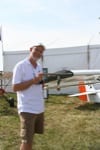 Flying is about having fun — and what could be more fun than the Belite, a single-place ultralight that’s engineered like a cross-country-capable Light Sport Aircraft?
Flying is about having fun — and what could be more fun than the Belite, a single-place ultralight that’s engineered like a cross-country-capable Light Sport Aircraft?
“It’s a single place ‘go out and have fun’ airplane,” says James Wiebe, founder, CEO and president of Belite Aircraft.
The company opened its doors in Wichita in January. By July it was producing aircraft and had a display in the experimental area of AirVenture. The curious gathered around the airplane like hunters around a mammoth.
The high-wing, taildragger design has a familiar look to it, reminiscent of the Kitfox family.
“This is not a Kitfox,” Wiebe says. “We bought the tooling for the aircraft formerly known as the Kitfox Lite but, just to clarify, we did not buy the Kitfox Lite. We got all that tooling and thought, ‘how can we make it better?’ We knew right away that we were going to make a carbon fiber wing because that is what we are into — carbon fiber.”
Improvements include a wood instrument panel, an electrical system, a carbon fiber floor board and a carbon fiber seat back, he said, adding, “We also changed the way the fuel tank worked and even put a fishing pole holder into the wings.”
 Wiebe demonstrated the fishing pole compartment in the leading edge of the wing. The end caps are held in place with a pin. Slide the pin out, remove the cap and slide the pole in, then reverse the process to replace the cap.
Wiebe demonstrated the fishing pole compartment in the leading edge of the wing. The end caps are held in place with a pin. Slide the pin out, remove the cap and slide the pole in, then reverse the process to replace the cap.
Wiebe said many of the refinements were done for greater safety. The carbon fiber wings, for example, are stronger than they need to be for safe flight, he noted.
“We also gave it a VFR panel electrical fuel gauge,” he said. “That way you don’t have to turn around and strain to look at a fuel gauge behind you. We also included a panel-mounted radio transceiver so you don’t have to clip it to a piece of tubing. We even included a transponder for our customers who want it.”
Wiebe noted that while many of his customers don’t normally fly in airspace that requires a transponder, having it built in will make flying safer because it will aid in separation from other aircraft.
“We also set it up with electric start,” he said. “I have done hand-propping, but I love being able to push that big red button and have the engine come to life.”
For the pilot who wants the ease of modern avionics, such as a handheld GPS, there is a gizmo dock in the panel.
“We wanted a designated place for it,” he said. “We have the antennae and the power set up there. All you have to do is click it into the panel so you don’t have to clip it to something and have it hanging out awkwardly.”
According to Wiebe, the Belite, which has foldable wings for easier storage, meets the weight limitations of Part 103 (254 pounds), so it is a true ultralight.
The powerplant is builder’s choice. Wiebe has evaluated an MZ-201, a two-stroke, two-cylinder 45-hp engine from Compact Radial Engines, as well as the MZ-34, and a Rotax 503. Some four-cylinder models are under consideration as well.
Build time is estimated at 200 hours. Kits start at $8,100, according to Wiebe, who says that with “careful shopping,” it’s possible to “have a homebuilt taildragger for anywhere between $10,000 and $17,000, depending on engine and panel.” The aircraft also is available in a ready-to-fly model for approximately $30,000.
LEARNING TO FLY
Because it is an ultralight, no medical certificate is required to fly the Belite.
As a single-place, learning to fly has to be done by the so-called “folklore” method — that is, getting experience in a similar aircraft then talking with people who have flown the Belite and getting some pointers.
“It handles very similar to a J-3 Cub,” he said. “We recommend getting a tailwheel endorsement and some experience in a J-3, then transitioning to the Belite.”
For more information: BeliteAircraft.com.
